Mampatti
Mampatti is a village in Singampunari Taluk[4] [5] in Sivagangai District of Tamil Nadu State, India. It comes under Mampatti South panchayath union. It is a constituent of the ancient "MayilrayanKottai Nadu" once, which was a part of 'Sivagangai Seemai'. For administrative purpose, the whole Mampatti region was divided into three Revenue Villages namely South Mampatti, North Mampatti and Mampatti Devasthanam, each under the authority of a Village Administrative Officer. Mampatti Devasthanam is the region that covers the land of temples that belongs to Sivagangai Samasthanam Devasthanam.[6][7][8][9] [10]
Mampatti | |
|---|---|
Village | |
 Sri Kadukavalar Temple | |
 Mampatti Location in Tamil Nadu, India  Mampatti Mampatti (India) | |
| Coordinates: 10.053406°N 78.493411°E | |
| Country | |
| State | Tamil Nadu |
| District | Sivaganga |
| Taluk | Singampunari |
| Government | |
| • Type | Grama Panchayat |
| Languages | |
| • Official | Tamil, English |
| Time zone | UTC+5:30 (IST) |
| Postal Code | 630566[1] |
| Telephone code | 04577[2] |
| Lok Sabha constituency | Sivaganga (Lok Sabha constituency)[3] |
| State Assembly Constituency | Tiruppattur_(state_assembly_constituency,_Sivaganga) |
Location
It is located 43 km North from District headquarters Sivagangai. Other nearby towns are Melur and Tirupathur. It is about 10 km away from Thirukoshtiyur which has one of the 108 Divya Desam temples dedicated to Lord Vishnu. Vishnu here called as Sowmya Narayana Perumal. Also it is about 19 km away from Pattamangalam which has one of the famous Guru temples dedicated to Lord Dakshinamurthy.[11][12] It is well connected to Tirupathur, Melur and Madurai by private and Tamil Nadu State Transport bus lines.[13][14]
History and people
It is a quiet and rustic village with long history. Agriculture is the predominant occupation of the people living here. Agriculture primarily depends on seasonal rainfall and the water coming through the river 'ManiMuthar'. Close to South Mampatti, there are 11 more villages situated which are administered and culturally linked to South Mampatti. Name of the 11 villages are 'Oppilanpatti, Santhirapatti, Thumbaipatti, Idaiyapatti, Kilukiluppaipatti, Thirupathipatti, M.Valaiyapatti, Kachapatti, Kalungupatti, Thoppupatti and Indira nagar'. Among this South Mampatti is the mother village for all (Tamil: தாய்க் கிராமம்).
Everyone knows the festival Deepavali/Diwali(Tamil: தீபாவளி), which literally means "row of lights" celebrated by Hindus across the world and is the most important festival in Hinduism. It is the celebration of good over evil, and light overcoming darkness. Regarding Diwali, astounding fact of this villages is that they never celebrate this festival. No new clothes, sweets or firecrackers here. For residents of the villages, Diwali has never been an occasion for celebration. For the past six decades, the villagers have shunned the festival. The reason behind this is that they faced a severe drought on that period and also the festival occurs at the wrong time of the year during October November, where everyone will be in the midst of Samba Season where they incur agricultural expenses.
While the entire village was suffering due to drought and agricultural expenses, few affluent families celebrated the festival, as usual indifferent to the plight of others. It hurt many of the people in villages, particularly the kids. That was when they decided not to celebrate it, by swears to the village deity Sri Kadukavalar Swamy. Everyone in the villages strictly adhere to the resolution adopted during a village meeting held 60 years ago(1958) headed by the Ambalakarar(President of an assembly)'Sevugan Ambalam' in order to maintain unity among villagers. Even those who moved from the village to settle elsewhere have not violated this unwritten diktat of the village.
Also many youths from villages moved to foreign countries for survival as no good spell of monsoon rains in this regions for a continuous time. Now the villagers' economic condition improved for some extent. But, they continued to shun celebrations. Youth who marry girls from this village are told about the practice in advance so that they do not expect to be honored during 'Thalai diwali'(Tamil: தலை தீபாவளி), the first diwali after marriage. However, the villagers celebrate Pongal in a grand manner wearing new clothes and preparing sweet Pongal along with the engagement of a bull taming sport called Manju Virattu(Tamil: மஞ்சு விரட்டு).
Apart from the above, Goat rearing(Tamil: வெள்ளாடு வளர்ப்பு) is also prohibited here in order to protect and safeguard smaller plants, flags and trees around the villages to preserve the village ecosystem. Only 'Sheep' culture(Tamil: செம்மறியாடு வளர்ப்பு) is allowed here. [15][16][17]
Temples
Sri Kadukavalar Swamy Temple
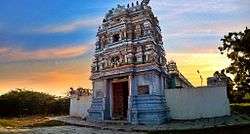
There are many temples around Mampatti. Main attraction of this region is "Sri Kadukavalar Swamy Temple"(Tamil: ஸ்ரீ காடுகாவலர் ஸ்வாமி திருக்கோவில்) which is a Constabulary God of this region that was worshiped by the peoples from surrounding villages. The Deity of this temple is called "Kadukavalar Swamy" (Tamil: காடுகாவலர் ஸ்வாமி)which is situated in the middle of 12 villages. As every village deity, this too situated in-between the shore of a Rivulet called 'ManiMuthar' and Lakes that running through the villages for cultivation. The rivers and tunnels flooding through this area get the source of water from the Tropical forest of Alagar Hills and Sirumalai Reserved Forest.[18][19]
Karanthamalai Aiyanar Temple

This is the Aiyanar Temple of this region worshipped by the 12 villages mentioned above and other nearby villages. 'Puravi Eduppu' is the festival that will be conducted once in every 3 years for this temple.
Chola Vinayagar and Choleswarar Temple
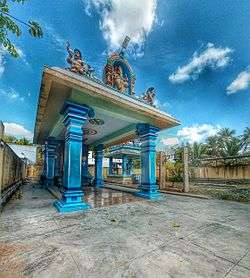
Chola Vinayagar/Cholesvarar Temple is a Hindu temple. The presiding deity of this temple is Lord Ganapathy. This ancient temple comes under the Jurisdiction of 'Sivagangai Samasthanam Devasthanam'(Tamil: சிவகங்கை சமஸ்தான தேவஸ்தானம்) which is administered by the Rani of Sivagangai, 'Sahiba Madurantaki Nachiar'.[20]
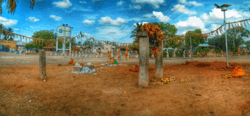
Another temple located in front of a village courtyard is 'Manthaiya Ayya'. The people entering into the village will worship this deity first.
Festivals
Vaikasi Thiruvizha
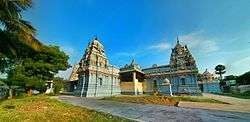
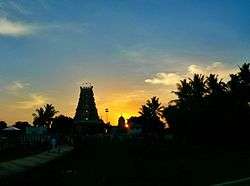
"Vaikasi Thiruvizha"(Tamil: வைகாசித் திருவிழா) festival celebrated every year in the month of May/June is one of the major annual festival in this village. It is a 5 days festival for Deities Lord "Piriya Vidai Nayanar(Shiva)" and Lordess "Ponnavidai Selvi(Parvathi)" situated in Vadavanpatti(Tamil: வடவன்பட்டி) village. This ancient temple comes under the Jurisdiction of 'Sivagangai Samasthanam Devasthanam'. Deities will be carried through the villages towards the river 'ManiMuthar' that flows near the village Oppilanpatti in order for a 'Ganga Snanam'. This festival attracts devotees from around the villages. Most of the natives living outside of the village returns home to participate in the festival.
Pongal Festival
Pongal (Tamil: பொங்கல் பண்டிகை), a harvest festival of Tamils which is celebrated on January. As an agriculture based civilization the harvest plays an important part in this region. The farmer cultivating his land depends on cattle, timely rain and the Sun. Once a year, he expresses his gratitude to these during the harvest festival, thanking the Sun God for agricultural abundance. This festival, Pongal, falls typically on the 14th or 15 January and is the quintessential 'Tamil Festival', a traditional occasion for giving thanks to nature. Families will gather to rejoice and share their joy with others. This is the major festival celebrated in this region which brings the natives back home.
On the day of Pongal, the puja is performed when rice is boiled in milk in an earthenware pot and is then symbolically offered to the sun-god along with other oblations. In accordance with the appointed ritual a turmeric plant is tied round the pot in which the rice will be boiled. The offerings include the sticks of sugar-cane in background and coconut and bananas in the dish.
Next day celebration is Mattu Pongal(Tamil: மாட்டுப்பொங்கல்), the day of Pongal for Cows and bulls. Multi-colored beads, tinkling bells, sheaves of corn and flower garlands are tied around the neck of the cattle and then are worshiped. They are fed with Pongal and Arati is performed on them, so as to ward off the evil eye. As Diwali is shunned in this region, this day festival will be celebrated in a grand manner, with bull taming sport called Manju Virattu(Tamil: மஞ்சு விரட்டு) at the end of the day.
Tying a 'Salli'(copper coin)(Tamil: சல்லிக்காசு) on the foreheads of the bulls, trained specially for this, the bulls are set loose. The competitors then try to capture the fierce bulls. The Tamil literature and the famous grammar Tolkappiyam(Tamil: தொல்காப்பியம்) which is created in the ancient Sangam period mentioned this sport as "Eru Taluvuthal"(Tamil: ஏறு தழுவுதல்).[21][22]
Puravi Eduppu Festival
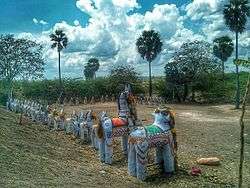
'Puravi Eduppu'(Tamil: புரவி எடுப்பு திருவிழா) is a festival beseeching the rain gods for their mercy. This is the festival taken for the deity Karanthamalai Aiyanar who protects the rural villages and their families. The festival of Aiyanar is decided upon by the entire village. After the decision has been taken, the god sometimes is consulted as well; he will answer e.g., through the "message of salvation". Once the decision made for conducting the festival, with a symbolic handful of earth from the temple the priest requests the potter (Velar) to make the necessary statues. The temple administration or the village pays for the statues of the deities and some of the horses; the devotee commissions his/her own votive offerings and pays for them. The potters also fashion the statues of the deities and of other items, be they animals or parts of the human body (legs, arms, eyes etc. offered in return for the healing of an illness). The statues are whitewashed and then painted with colors. Large old clay(terracotta) horses reaching a height of two meters and more, wonderfully molded and with intricate decorations with Vestis, Flower garlands. Devotees decorate their votive offerings themselves with flowers, pieces of cloths, balloons, pin-wheels, mirrors, etc.,.
Over a padding of straw tied to the sides of the larger statues, two wooden poles are fastened with which the statues can be carried. The smaller statues are carried on the head or shoulder of a person. The horses that given to the god denotes status, strength, power and royal qualities. once the priest completes performing Puja for all the terracotta's, the clay statues eyes are opened and then carried at a fast pace to the temple, where they receive a place in front of the old statues. This terracotta horses seen inside the compound are given to the god in order to walk around his territory on night time to assert and record its boundaries.[23]
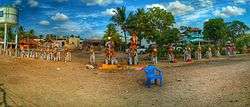
Sevvai Pongal
‘Sevvai Pongal’(Tamil: செவ்வாய்ப் பொங்கல்) is a traditional community festival celebrated on the last Tuesday of Tamil month 'Karthigai'(mid-November to mid-December). This will happen in the entire 'MayilrayanKottai Nadu' region, which is another annual occasion for villagers to come together.
All the community members come together to make 'White Pongal' to offer worship for the deity 'Amman', in order to protect 'Crops' and 'Plants' in the Paddy Fields. Though the worship is for God, the occasion will happen in front of a square shed raised platform, which will be seen in most of the villages. This open 'dais' normally built in front of a house, temple or a village for general use. It is the property of the entire community and a Place of public assembly of the village. The peoples in the village will gather at this common place for sitting and gathering. In Tamil language this is called as "Savukkai/Chavadi(சவுக்கை/சாவடி)."
Apart from making pongal, in some villages devotees will make Mavilakku, a rice made flour with milk and coconut, offering for the Goddess to appease her and to get her blessings.[24]
References
- "Archived copy". Archived from the original on 11 March 2015. Retrieved 11 March 2015.CS1 maint: archived copy as title (link)
- http://www.indiacom.com/yellowpage/stdlink.asp
- "Archived copy" (PDF). Archived from the original (PDF) on 2 April 2015. Retrieved 24 March 2015.CS1 maint: archived copy as title (link)
- http://www.newindianexpress.com/states/tamil-nadu/2016/sep/17/CM-orders-creation-of-five-new-taluks-1520754.html
- "Archived copy". Archived from the original on 28 September 2017. Retrieved 27 September 2017.CS1 maint: archived copy as title (link)
- http://tnmaps.tn.nic.in/vill.php?dcode=23¢code=0001&tlkname=Tirupathur#MAP
- http://tnmaps.tn.nic.in/blks_info.php?dcode=23&blk_name=Singampunari&dcodenew=25&drdblknew=7
- http://tnmaps.tn.nic.in/pr_villages.php?dc=23&tlkname=Singampunari®ion=7&lvl=block&size=1200
- Sivaganga district
- http://www.tnrd.gov.in/databases/Villages.pdf
- http://temple.dinamalar.com/en/new_en.php?id=642
- http://www.sivagangaiseemai.com/pattamangalam-guru-temple.html
- Thirukoshtiyur
- http://tnmaps.tn.nic.in/pr_villages.php?dc=23&tlkname=Tirupathur®ion=0001&lvl=taluk&size=1200
- 56 ஆண்டுகளாக தீபாவளியை துறந்த கிராம மக்கள்: பரபரப்பு இல்லாத 12 பட்டி கிராமங்கள்
- பொருளாதாரத்தில் ஏற்றத்தாழ்வு: 53 ஆண்டுகளாக தீபாவளியைப் புறக்கணிக்கும் கிராமம்
- http://www.dinamani.com/all-editions/edition-madurai/sivagangai/2017/oct/18/சிவகங்கை-அருகே-60-ஆண்டுகளாக-தீபாவளி-கொண்டாடாத-12-கிராமங்கள்-2792149.html
- http://www.mapsofindia.com/maps/tamilnadu/rivers/sivaganga.html
- https://www.openstreetmap.org/#map=13/10.2309/78.1540
- http://sivaganga.tn.nic.in/history.html
- Peter J. Claus; Sarah Diamond; Margaret Ann Mills (2003). South Asian Folklore: An Encyclopedia : Afghanistan, Bangladesh, India, Nepal, Pakistan, Sri Lanka. Taylor & Francis. pp. 593–. ISBN 978-0-415-93919-5.
- http://www.pongalfestival.org/
- Eveline Masilamani-Meyer (2004). Guardians of Tamilnadu: Folk Deities, Folk Religion, Hindu Themes. Otto Harrassowitz Verlag. pp. 161–. ISBN 978-3-931479-61-9.
- https://www.wisdomlib.org/definition/chavadi/index.html